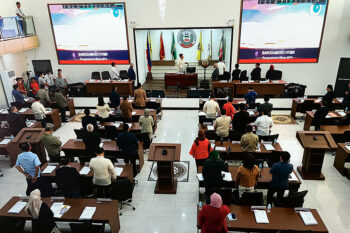
MALAYBALAY CITY (MindaNews / 8 September) — It’s being flaunted as the golden age of the Philippines. Yet, aside from the gross human rights violations, the rule of disgraced strongman Ferdinand E. Marcos could not boast of a sterling economic performance. Supporters and paid trolls, regardless of their noise and number, could not refute statistics.
Figures published in https://www.macrotrends.net and in other websites debunk claims that the Philippine economy was only second to Japan in the whole of Asia during Marcos’ rule, which lasted from 1965 until February 1986. Its performance even paled in comparison to ASEAN neighbors like Singapore and Malaysia.
Take, for instance, the country’s gross domestic product (GDP) and per capita GDP. GDP is defined as the total value of goods produced and services provided in a country during one year. Per capita GDP measures a country’s economic output per person and is calculated by dividing the GDP of a country by its population.
Throughout the 21-year Marcos regime, the country’s GDP never attained a double-digit growth rate. The highest growth rate stood at 8.78%, in 1973 and 1976, in both instances rebounding from a growth rate of slightly over 5%.
During the first 10 years, from 1965 until 1974, the average GDP growth rate was only 5.14%. From 1976 until 1985, the average slid to 2.80% due to negative growth rates in 1984 (-7.04%) and 1985 (-6.86%) and the measly 1.90% growth rate in 1983, the year popular opposition leader former senator Benigno “Ninoy” Aquino was assassinated upon his return from exile in the United States. His murder sparked more protest actions across the country.
In addition, the GDP sustained negative annual changes in its growth rates eleven times, eight occurring from 1966 to 1980.
Singapore, meanwhile, registered double-digit GDP growth rates 10 times, from 1965 until 1985. Except for 1975 (3.99%) and 1985 (-0.62%) the island city-state’s GDP growth rate never fell below the 6% mark (1974 and 1977); most of the single-digit performances stood at the vicinity of 7% to 9%. Its average growth rate for the 21-year period was 8.60%.
For its part, Malaysia recorded an average GDP growth rate of 7.00% from 1965 until 1985. The year 1985 though sustained a negative growth rate (-1.03%), and the figure was also dismal in 1975 (0.80%). In 1985, among other factors, the London Metal Exchange suspended tin trading, affecting a pillar of the country’s prosperity.
However, Malaysia registered double-digit GDP growth rates in 1971, 1973 and 1976. For most of the 21-year period, the growth rates mostly hovered above the 7% mark.
Likewise, the Philippines lagged behind Malaysia and Singapore in terms of per capita GDP (measured in US dollars) during the same period in review.
In 1965, Marcos’ first year as president, the Philippines per capita GDP was $211, remained below $300 until 1973, and even slipped back to $211 in 1970. The highest level was reached in 1982 ($844), only to decrease in the dictator’s last three years in office, dropping to $644 in 1985.
Singapore’s per capita GDP stood at $517 in 1965, or 12 years before the Philippines’ record of $511. In 1971, Singapore already reached a per capita GDP of $1,071, peaking at $7,002 in 1985, over 1,000% more than the Philippines’ for the same year.
Also during the 21-year period, Malaysia posted much higher per capita GDP growth rates than the Philippines. In 1965, the figure was $310. After 10 years, it increased to $800, peaking at $2,234 in 1984 before dropping to $2,000 the next year.
It can be argued that Malaysia and Singapore have much higher per capita GDP due to their smaller populations. Further, a country may enjoy consistent economic growth but if its population growth outpaces the GDP, per capita GDP will be negative.
However, despite their respective populations of over 1 billion people, China and India have per capita GDP growth rates higher than the global average in this century. Economists attributed this achievement to the financial reforms made by the two economies.
(MindaViews is the opinion section of MindaNews. H. Marcos C. Mordeno can be reached at hmcmordeno@gmail.com.)







